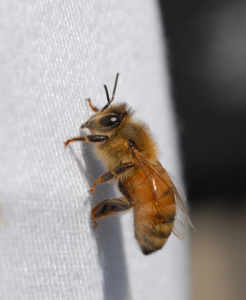Adapted from the article “Honey Bee Safety During Bloom” by Emily J. Symmes, UCCE Area IPM Advisor, Sacramento Valley in the December 2014 Sacramento Valley Almond News.
Honey bee safety is not a new concept in agriculture, particularly for almond growers, so be sure to follow best practices for honey bee health during almond pollination. The importance of communication cannot be emphasized enough. All parties should be kept informed so beekeepers are aware of impending applications and applicators are aware of the requirements related to notification, materials, timing, location, and method of application. This includes growers, beekeepers, land owners-lessees, PCAs, pesticide applicators, and county agricultural commissioners.

Honeybee.
General guidelines:
- Employ sound IPM practices. Apply pesticides only when absolutely necessary based on population monitoring and treatment thresholds, know all of the available treatments, treatment timings, and their impacts on pollinators and other non-target organisms.
- Always provide adequate clean water for bees. Cover or remove water sources prior to any application. Keep water clean and fresh ensures bees spend more time pollinating the crop than searching for water. Bees can forage up to 5 miles away seeking food and water if not available in the orchard, increasing their risk of contact with harmful pesticides.
- Do not spray hives directly with any pesticide. Ensure the spray-rig driver turns off nozzles when near hives.
- Do not spray flying bees with any applications. Aside from toxicity concerns, bees will not be able to fly because of the weight of spray droplets on their wings.
- Avoid pesticide application or drift onto blooming weeds in or adjacent to the orchard.
- Avoid applying systemic pesticides or those with extended residual toxicities pre-bloom.
- Agree on proper hive removal timing. Bees should be removed from the orchard when 90 percent of flowers on the latest blooming cultivar are at petal fall. Past this point, no pollination is taking place.
- After removal of bees from an orchard, communication with neighbors remains important because other bees may still be foraging nearby.
Insecticide guidelines:
- Avoid applying insecticides during bloom until more is known. Much of the information and labeling related to honey bee toxicity is based on acute toxicity of foraging adults. In recent years, more research has indicated negative effects of pesticides on developing brood, so even materials with “softer” reputations toward honey bees should be avoided. One exception is Bacillus thuringiensis (Bt), which may be used at petal fall and shortly after for control of peach twig borer. For more information, see the UC IPM Guidelines for PTB in almonds.
- Rely on other effective timing options (delayed dormant, post-bloom) for pest management. UC IPM Guidelines for almonds provide monitoring information and insecticide and treatment timing options.
Fungicide guidelines:
- If fungicide treatment is necessary, apply fungicide materials alone.
- Never tank mix with insecticides during bloom. Increasing evidence shows that synergistic effects of fungicides with insecticides can be more harmful to both adult bees and the developing brood than either material alone.
- Addition of adjuvants for bloom fungicide applications are not necessary unless specified on the label, and may harm bees by increasing fungicide toxicity to the bee and/or impact their behavior directly. Limited leaf area should allow good spray coverage as long as the sprayer is well calibrated and properly set up, so addition of adjuvants should not be needed at bloom.
- Apply fungicides in the late afternoon or evening when bees and pollen are not present. Each morning new flowers and anthers open to release pollen. Pollen-collecting bees often collect all of this pollen and leave the almond blossoms by mid-afternoon. Pollen that will be collected the next day is still protected inside closed flowers or anthers, which will not open until morning. It is important to ensure that fungicides have time to dry before new flowers open, anthers shed pollen, and bees begin foraging the following day.
- Know the impacts of particular fungicides on honey bees and choose materials accordingly. The following fungicides have significant negative impacts on hive health and should be avoided during bloom: Rovral, Captan, and Ziram.
If you suspect pesticide-related damage to honey bees, immediately report this to your county agricultural commissioner. Preserving some adult bees, brood, pollen, honey, nectar, and/or wax by immediately collecting and freezing in clean, labeled containers may be helpful for follow-up on the incident. Signs to look for:
- Excessive numbers of dead or dying adult honey bees in front of hives
- Dead newly-emerged workers or brood (developing larvae) at the hive entrance
- Lack of foraging bees on a normally attractive blooming crop
- Adult bees exhibiting stupefaction (dazed, unconscious, etc.); paralysis; jerky, wobbly, or rapid movements; spinning on the back
- Disorientation and reduced efficiency of foraging bees
- Immobile or lethargic bees unable to leave flowers
- Bees unable to fly and crawling slowly as if chilled
- Queenless hives
Additional resources:


Leave a Reply